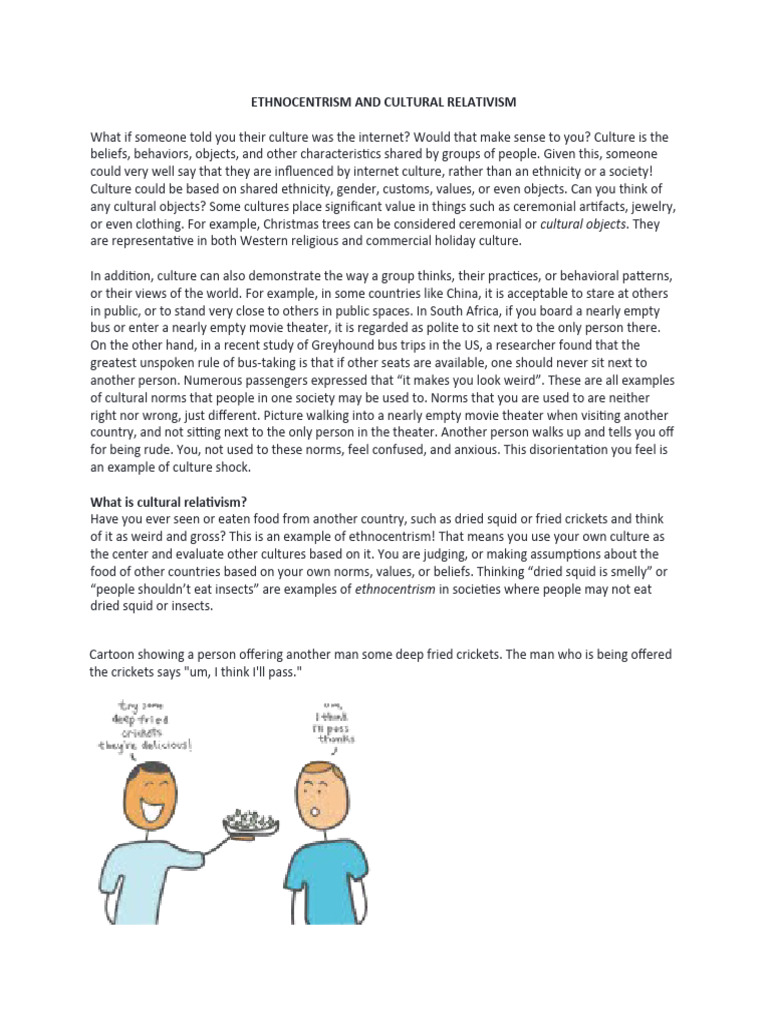In the kaleidoscopic tapestry of human cultures, two concepts stand out prominently: ethnocentrism and cultural relativism. Each serves as a lens through which individuals and societies perceive and interpret differences in cultural practices, values, and norms. Ethnocentrism, in its essence, can be likened to a fish swimming in its own water, blissfully unaware of the vast ocean of perspectives that exists beyond its immediate environment. In contrast, cultural relativism opens the doors to an expansive realm of understanding, akin to stepping onto a vibrant marketplace bustling with diverse ideas and practices.
Understanding Ethnocentrism
Ethnocentrism is the proclivity to view one’s own culture as the epitome of normalcy or superiority. This cognitive bias is often cloaked in the guise of tradition or heritage, yet it acts as a formidable barrier to cross-cultural understanding. When viewed through the prism of ethnocentrism, diverse customs may be misconstrued as barbaric or inferior. For instance, a society that celebrates communal living may be viewed through a distorted lens of dismissal by those who prize individualism. Such perspectives are not merely opinions; they can engender significant social rifts and perpetuate systemic inequalities.
To grasp the implications of ethnocentrism, consider the metaphor of a monocultural garden. Within this space, only singular species thrive, each vying for resources while simultaneously rejecting anything that disrupts their homogeneity. Without the vibrant colors and unique aromas of different plants—each contributing its own benefits—the garden becomes stagnant, devoid of the richness that diversity brings.
The Carrot of Cultural Relativism
Cultural relativism, the antithesis of ethnocentrism, posits that one’s beliefs and practices should be understood based on the context of their own culture. Cultural relativists advocate for an appreciation of the myriad tapestries interwoven into the global human experience. This doctrine encourages individuals to transcend their preconceived notions, embarking on a quest for deeper understanding. By fostering empathy and open-mindedness, cultural relativism is a powerful tool for harmony in an increasingly interconnected world.
A fruitful metaphor for cultural relativism is the kaleidoscope. By looking through its lens, observers can appreciate how simple adjustments in perspective create intricate patterns, highlighting the beauty inherent in diversity. Every twist brings forth a unique arrangement, demonstrating that variations in culture enrich our global narrative rather than detract from it. Through this lens, respect becomes paramount, transforming what could have been a moment of judgment into one of enlightenment.
Ethnocentrism and Cultural Relativism in Practice
When applied to modern society, the interplay between ethnocentrism and cultural relativism influences global interactions, particularly regarding issues such as immigration, international relations, and environmentalism. The perception of foreigners often oscillates between these two ideologies. It is not uncommon for individuals to harbor feelings of superiority regarding their customs, particularly when confronted with alternative ways of living or governance.
In the realm of environmental activism, this dichotomy can result in polarized responses. Some communities may default to ethnocentric attitudes, decrying foreign practices as imprudent or damaging without contextual understanding. Conversely, employing a cultural relativist lens can render foreign approaches to environmental stewardship not only valid but instructive. Many indigenous cultures, for instance, harbor centuries of ecological wisdom that can contribute significantly to sustainable practices. When their views are embraced rather than dismissed, collaborative efforts can emerge, leading to innovative solutions that respect both local traditions and global needs.
The Importance of Dialogue
Engaging in dialogue is essential for navigating the complexities birthed from ethnocentrism and cultural relativism. Facilitating conversations among individuals from diverse backgrounds can unveil common goals, fostering an environment ripe for cooperation. Just as a symphony arises from the harmonious convergence of various instruments, so too can solutions to global challenges emerge from a plethora of cultural insights and experiences.
Through workshops, intercultural exchanges, and educational initiatives, individuals can cultivate a more comprehensive understanding of one another. Such engagements transform ethnocentric tendencies into a celebration of pluralistic identities. They reinforce the notion that a single narrative, as compelling as it may seem, lacks the fullness of the human experience.
Transformative Power of Embracing Diversity
The integration of both perspectives necessitates a paradigm shift, moving from a framework of superiority to one of shared humanity. The collective challenge lies in overcoming deeply ingrained biases while celebrating the mosaic of human cultures that enrich our global community. By doing so, individuals cultivate not only an appreciation for difference but a commitment to collaboration—an essential component of progress.
In summation, understanding ethnocentrism and cultural relativism transcends mere academic exploration. It invites humanity into a dance of dialogue, promoting awareness, respect, and cooperation. By recognizing the intricate interplay between these perspectives, societies can foster environments ripe for innovation and growth, ensuring that the garden of humanity flourishes with a diversity that celebrates its collective past while nurturing its hopeful future. The awareness of this dynamic not only broadens horizons but also champions the pursuit of a unified global community able to confront the multifaceted challenges of our time.
